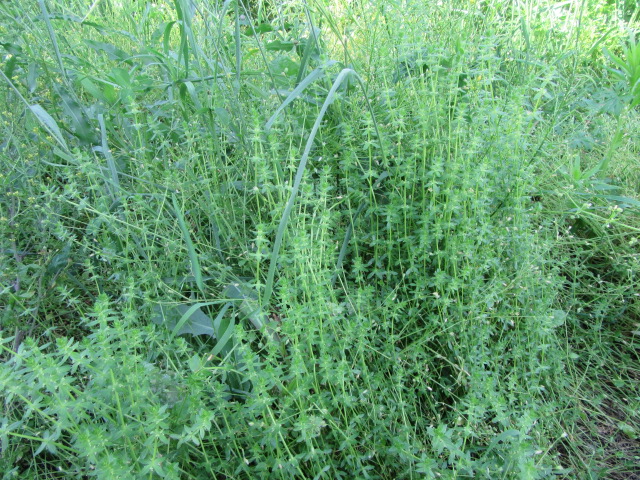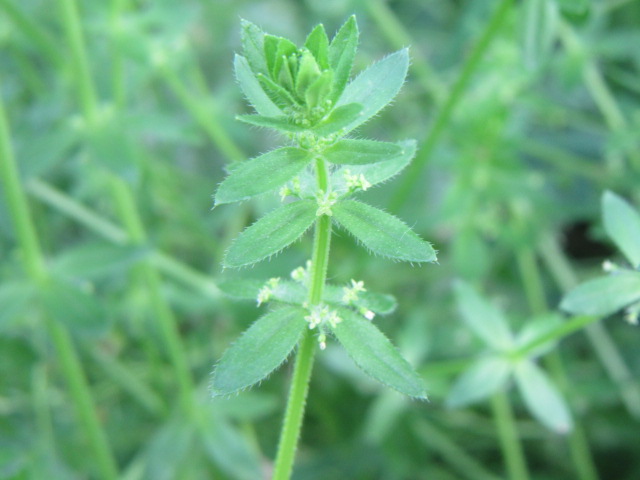
Cruciata pedemontana (Piedmont Bedstraw) on 5-22-22, #882-4.
Piedmont Bedstraw, Foothill Bedstraw, Bedstraw
Cruciata pedemontana
(Cruciata pedemontana var. pedemontana)
kruks-ee-AY-tuh ped-ee-MON-tah-nuh
Synonyms of Cruciata pedemontana (3) (Updated on 12-24-23 from Plants of the World Online): Cruciata pedemontana var. reflexa (C.Presl) Soó (1963), Galium pedemontanum (Bellardi) All. (1773), Valantia pedemontana Bellardi (1788)
Synonyms of Cruciata pedemontana var. pedemontana (20) (Updated on 12-24-23 from POWO): Cruciata pedemontana var. glabrescens (Bég.) Soó (1965), Cruciata pedemontana var. reflexa (C.Presl) Soó (1963), Cruciata pedemontana var. vestita (Rouy) Soó (1973), Cruciata schischkinii (Pobed.) Pobed. (1970 publ. 1971), Galium chloranthum Brot. (1804), Galium pedemontanum var. aspericaule Rouy (1887), Galium pedemontanum var. glabrescens Bég. (1903), Galium pedemontanum f. glabrescens (Bég.) Bolzon (1904), Galium pedemontanum var. inermis Caruel (1887), Galium pedemontanum var. laevicaule Rouy (1887), Galium pedemontanum var. longepilosum Sennen & Mauricio (1936), Galium pedemontanum var. reflexum (C.Presl) DC. (1830), Galium pedemontanum var. vestitum Rouy (1887), Galium platypodum Borbás ex Formánek (1896), Galium reflexum C.Presl (1819), Galium retrorsum DC. (1830), Galium schischkinii Pobed. (1958), Valantia aspera Roem. & Schult. (1818), Valantia granulata Roth ex Willd. (1806), Valantia hispida Lumn. (1791)(nom. illeg.)
Cruciata pedemontana (Bellardi) Ehrend. is the accepted scientific name for this species. It was named and described as such by Friedrich Ehrendorfer in Annalen des Naturhistorischen Museums in Wien in 1962. It was first named and described as Valantia pedemontana by Carlo Antonia Lodovico Bellardi in Osservazioni Botaniche in 1788.
Accepted Infraspecific Names (2) (Updated on 12-24-23 from POWO): *Cruciata pedemontana var. pedemontana (autonym), Cruciata pedemontana var. procumbens (Asch.) Soó (1965). *When an infraspecific taxon is named, an autonym (“type-specimen”) is automatically generated that is closest to the (original) species. Usually, all have their own list of synonyms. Plants in North America are assigned to the autonym.
The genus, Cruciata Mill., was named and described by Philip Miller in the 4th edition of The Gardeners Dictionary in 1754.
As of 12-24-23 when this page was last updated, Plants of the World Online lists 8 species in the genus Cruciata. It is a member of the plant family Rubiaceae with 611 genera. Those numbers could change as updates are made on POWO.

Distribution map of Cruciata pedemontana from Plants of the World Online. Facilitated by the Royal Botanic Gardens, Kew. Published on the Internet; http://www.plantsoftheworldonline.org/. Retrieved on August 4, 2022.
The above distribution map for Cruciata pedemontana is from Plants of the World Online. Areas in green are where the species is native and purple are where it has been introduced. The map on the USDA Plants Database is much different… POWO gets their maps from Flora of North America, but they don’t include the species YET. When they do, POWO will update their maps. I used this map mainly to show where the species is native.

Distribution map for Cruciata pedemontana from the USDA Plants Database. Published on the internet at https://plants.sc.egov.usda.gov/home. Retrieved on August 5, 2022.
The above distribution map for Cruciata pedemontana is from the USDA Plants Database. It shows a much broader range…
The map on iNaturalist shows where members have made observations. Anyone can join and it is a great website to confirm and share your observations. The maps on iNaturalist are continually updated as members post new observations.
THERE ARE SEVERAL LINKS AT THE BOTTOM OF THE PAGE FOR FURTHER READING AND TO HELP WITH A POSITIVE ID.

Cruciata pedemontana (Piedmont Bedstraw) on 5-1-22, #877-7.
I had been seeing small colonies of this species here and there on the farm and thought I had it identified already. I took a few photos of a small colony in the back pasture on May 1 in 2022 and uploaded them on iNauralist. Then, I couldn’t find them on my list or in the photo folders on my computer. So, apparently, I hadn’t identified the species until 2022 after all. Anyway, the species was identified as Cruciata pedemontana, but some websites use the scientific name Galium pedemontanum which is the same thing. Well, the latter is now considered a synonym…
Common names include Piedmont Bedstraw, Foothill Bedstraw, Bedstraw, and likely others. It shares the common name Bedstraw with other species such as Galium aparine which is also called Cleavers, Catchweed Bedstraw, etc. It is fairly common and has hooked hairs that stick to clothing and hairy arms… I used to play with it when I was a kid…

Cruciata pedemontana (Piedmont Bedstraw) on 5-1-22, #877-8.
Cruciata pedemontana is a Eurasian native that was first found in Missouri in the 1970’s. By 2020 it was reported in 43% of the counties in the state. It was first discovered near Lexington, Kentucky in 1933. It is found sporadically in other parts of the country, but it could be under-reported due to its ability to hide in taller grass and spread so well. I just happened to stumble upon it when I did find it.
Cruciata pedemontana is an annual species that grows in full to part sun in moist to dry conditions in just about any type of soil. Plants can grow to 16” tall in ideal conditions.

Cruciata pedemontana (Piedmont Bedstraw) on 5-22-22, #882-5.
The thin stems grow erect at first then can be a little sprawly as they get taller because of their spindly stems.

The above photo shows multiple stems from the base of Cruciata pedemontana is from the Missouri Plants website. Missouri Plants is published on the internet at http://www.missouriplants.com/index.html. Photo used by permission and retrieved on February 21, 2024.
Usually, multiple stems grow from the base and are densely covered with short and long straight white hairs (pubescent) and prickly downward curved hairs giving them a rough texture.
(Looking at the hairs with magnification, they are pretty long considering the diameter of the stems.)
The stems produce whorls of 4 leaves per node, 3-11 mm long, narrowly elliptic to lanceolate in shape, rounded or angled to a blunt or sharp pointed tip.

The above photo of Cruciata pedemontana inflorescence and leaves is from the Missouri Plants website. Missouri Plants is published on the internet at http://www.missouriplants.com/index.html. Photo used by permission and retrieved on February 21, 2024.
Small flowers grow from the leaf axils (upper part of the leaf node) either as a single flower or in groups of 2-4. Compared to the size of the leaves and flowers, the peduncles (flower stems) are quite long…

The above photo of Cruciata pedemontana flowers is from the Missouri Plants website. Missouri Plants is published on the internet at http://www.missouriplants.com/index.html. Photo used by permission and retrieved on February 21, 2024.
The tiny perfect flowers are about 1/16 across and consist of a yellowish green to pale yellow 4-lobed corolla (petals), 4 stamens with an exerted yellow anthers, a green pistol, a 2-lobed style, 2 stigmas, and a 2-locular ovary with 1 oval per locule. Some flowers may be imperfect and lack either the male or female reproductive parts. The flowers stand more upright at first, then spread out more and droop between the leaves. It makes them look like they are growing from in between the leaves.
Flowering begins in April and lasts through May or a little longer depending on the weather. The flowers attract small bees and flies for the pollen and nectar, even though they produce very little per flower.

The above photo of Cruciata pedemontana leaf abaxial and fruit is from the Missouri Plants website. Missouri Plants is published on the internet at http://www.missouriplants.com/index.html. Photo used by permission and retrieved on February 21, 2024.
Once the peduncles (flower stems) start drooping, the ovaries produce fruit called schizocarps which are held below the leaves. Each fruit contains 2 seeds.
Cruciata pedemontana can spread fairly rapidly in pastures and hayfields since their flowers go to seed in only a few days. I read an article from ON PASTURE that says they make a good forage plant with around 19% protein… Hmmm…
I appreciate being able to use photos from the Missouri Plants website. Missouri Plants is my number one source for identifying wildflowers on the farm and other areas around where I live. They have great descriptions and photos. Photos are available for non-commercial educational uses as long as proper citation is given.
I need to take better photos, hopefully in 2024, so I can replace what I have borrowed… Everything with Cruciata pedemontana is very small, but practice makes perfect.
I have enjoyed photographing and learning about the many wildflowers growing on the family farm and in other areas nearby. The farm is in Windsor, Missouri in Pettis County (Henry County is across the street, and Benton and Johnson aren’t far away). I have grown over 500 different plants and identified over 250 species of wildflowers (most have pages listed on the right side of the page). I am not an expert, botanist, or horticulturalist. I just like growing, photographing, and writing about my experience. I rely on several websites for ID and a few horticulturalists I contact if I cannot figure them out. Wildflowers can be somewhat variable from location to location, so sometimes it gets a bit confusing. If you see I have made an error, please let me know so I can correct what I have written.
I hope you found this page useful and be sure to check the links below for more information. They were written by experts and provide much more information. Some sites may not be up-to-date but they are always a work in progress. If you can, I would appreciate it if you would click on the “Like” below and leave a comment. It helps us bloggers stay motivated. You can also send an email to me at thebelmontrooster@yahoo.com. I would enjoy hearing from you especially if you notice something is a bit whacky.
FOR FURTHER READING:
PLANTS OF THE WORLD ONLINE (GENUS/SPECIES)
INTERNATIONAL PLANT NAMES INDEX (GENUS/SPECIES)
TROPICOS (GENUS/SPECIES)
WORLD FLORA ONLINE (GENUS/SPECIES)
WIKIPEDIA (GENUS/SPECIES)
USDA PLANTS DATABASE
MISSOURI PLANTS
MSU-MIDWEST WEEDS AND WILDFLOWERS
iNATURALIST
WILDFLOWER SEARCH
ILLINOIS WILDFLOWERS
MARYLAND BIODIVERSITY PROJECT
SEINet
UNIVERSITY OF WASHINGTON/BURKE HERBARIUM
ON PASTURE
NATURESCENE’S FLORA OF THE CÉVENNES
NOTE: The data (figures, maps, accepted names, etc.) may not match on these websites. It depends on when and how they make updates and when their sources make updates. Some websites have hundreds and even many thousands of species to keep up with. Accepted scientific names change periodically and can be hard to keep with. Some of the links may use a name that is a synonym on other sites. In my opinion, Plants of the World Online by Kew is one of the most reliable and up-to-date plant databases and they make updates regularly. I make updates “at least” once a year and when I write new pages or add new photos but I do get behind. We are all a work in progress. 🙂